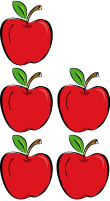Algebra/Chapter 1/Arithmetic
| The Number Line | Algebra Chapter 1: Elementary Arithmetic Section 2: Operations in Arithmetic |
Exponents and Roots |
1.2: Operations in Arithmetic
Arithmetic is the process of performing certain operations on quantities. In this section, we will cover four of the arithmetic operations: addition, subtraction, multiplication, and division, as well as how these operations are related to one another.
Groups of Numbers
[edit | edit source]For the purposes of understanding operations involving numbers, we will first discuss what we mean by an "operation" as well as the groups of numbers that they occur in.
In an operation, we take one or more numbers of interest, and perform a procedure on them to receive a new number, or the result of the operation. A group of two numbers may be combined together with a given operation to produce a third number.
The Four Basic Operations
[edit | edit source]The four operations of mathematics take two different values, and convert them to a new value. These include:
Addition: +
[edit | edit source]The combining of values.
Subtraction: -
[edit | edit source]The taking away of one value from another.
Multiplication: ×
[edit | edit source]Repeated addition.
Division: ÷
[edit | edit source]Repeated subtraction.
These four operations are commonly referred to as arithmetic operations. These are considered the cornerstones of all of mathematics.
Addition
[edit | edit source]Defining Addition
[edit | edit source]
To define the number one is a rather difficult task, but we all have a good intuitive sense of what "oneness" is. Oneness is the property of having or thinking of a singular quantity. For example, think of when you have one dollar, one bushel of potatoes, or one light year. From here we can recursively (that is, relating to the last one) define the natural numbers by assigning a new name for each new number of ones that we have:
| 1 | 1 | one |
| 2 | 1 + 1 | two |
| 3 | 1 + 1 + 1 | three |
| ⋮ | ⋮ | ⋮ |
| n | 1 + 1 + … + 1 | n ones |
|
Example 1.1: Now that we have named the numbers using the number one we can define addition as the process of counting how many ones we have. For example, |
In the above, notice that we represent the numbers 5 and 3 as a repeated addition of 1 in parentheses, which we subsequently added together.

Performing Addition
[edit | edit source]Addition is the mathematical operation which explains the total amount of objects which we put together in a collection. In addition, the numbers being added together are called addends or terms, and the end result is referred to as the sum.
|
Example 1.2: Tony and Aaron's aunt came to visit. She gave each of the boys 25 marbles. Tony won 12 marbles from Aaron during the visit. How many marbles did Tony have after they played? |
Addition has several important properties. One of these properties is that the order you add the numbers will not effect the final result. Refer to the diagram of the apples above. Much like how we can add 3 apples to a group of 2 will result in 5 apples in total, we can add 2 apples to a group of 3 to get 5 apples in total.
Subtraction
[edit | edit source]Defining Subtraction
[edit | edit source]Subtraction is the term we use to describe how we "take away" one or more numbers from another. The term is used in two types of situations. The first is to answer the question of "how much is less?", and the second is "how much is needed?"
It can likewise be defined as counting initial quantity of ones and removing some amount of them.
|
Example 1.3: We can define subtracting as the process of counting how many ones we are removing. means 5 ones remove 3 ones, leaving a result of 2 ones. |
The term we are subtracting from is called the minuend. The number that is being subtracted is called the subtracthend. The resulting number is called the difference.
Multiplication
[edit | edit source]Multiplication is a shorthand (that is, a faster way of writing something) for repeated addition. For example:
What this means is to add up '3' 5 times; or add up '5' 3 times.
Note that in some regions and cases, it is better to use the cross symbol () or the letter "x" instead of the dot. Most regions use the dot instead of the cross symbol because the cross symbol looks like the letter "x".
Multiplication Table
[edit | edit source]Division
[edit | edit source]Division is the opposite of multiplication.
This example asks if six is 1+1+1+1+1+1, and three is 1+1+1, then how many sets of three can we break six into? The answer is of course 2, because
; two sets of three.
Division is the first operation where a problem arises. In all the previously defined operations (addition, subtraction, and multiplication) we could perform the operation on any pair of numbers we chose. However, with division we cannot divide by zero. Much will be said about this fact throughout the course of this book, and even through your studies in all of mathematics.
Inverse Operations
[edit | edit source]An inverse operation undoes what was done by the previous operation, they are exact opposites of each other.
Basic Applications of the Four Operations
[edit | edit source]Converting between Fractions and Decimals
[edit | edit source]While fractions and decimals both essentially represent the same thing, one may be better suited for a problem than the other.
Operations Involving Zero
[edit | edit source]- 1 + 0 = 1
- 1 * 0 = 0
- 0 / 1 = 0
- 1 / 0 = Undefined









